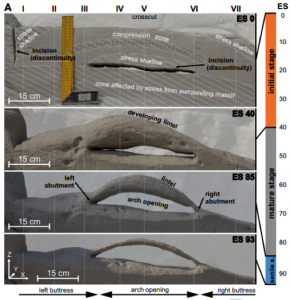 People tend to admire well-developed rock arches and bridges as a symbol of perfection in nature. However, the origin of such arches still remains unclear, with different authors emphasizing different factors as essential. An authentic small-scale physical model of a perfect arch was created in situ from friable sandstone through a simulation of natural erosion. Based on three-dimensional photogrammetric and numerical modeling, we established three evolutionary stages of the modeled arch: the initial, mature, and senile stages. Erosion removed the material from stress shadows, thus exposing the compressed zone of the material, which spans over the discontinuity. From its original lintel thickness with a length ratio of 0.3, the modeled arch thinned out to a ratio of 0.03, which is close to the best-developed natural arches. The erosion rate of the arch surface was relatively low for 90% of its lifespan, but the last 10% was characterized by an abrupt increase in the erosion rate. Our results show that the only conditions essential to producing a delicate arch through erosion are a thin, vertically elongated rock body with an appropriate discontinuity, and a material prone to stress-controlled erosion.
People tend to admire well-developed rock arches and bridges as a symbol of perfection in nature. However, the origin of such arches still remains unclear, with different authors emphasizing different factors as essential. An authentic small-scale physical model of a perfect arch was created in situ from friable sandstone through a simulation of natural erosion. Based on three-dimensional photogrammetric and numerical modeling, we established three evolutionary stages of the modeled arch: the initial, mature, and senile stages. Erosion removed the material from stress shadows, thus exposing the compressed zone of the material, which spans over the discontinuity. From its original lintel thickness with a length ratio of 0.3, the modeled arch thinned out to a ratio of 0.03, which is close to the best-developed natural arches. The erosion rate of the arch surface was relatively low for 90% of its lifespan, but the last 10% was characterized by an abrupt increase in the erosion rate. Our results show that the only conditions essential to producing a delicate arch through erosion are a thin, vertically elongated rock body with an appropriate discontinuity, and a material prone to stress-controlled erosion.
Řihošek J., Slavík M., Bruthans J., Filippi M. (2019): Evolution of natural rock arches: A realistic small-scale experiment. Geology 47, 71–74. (DOI)








